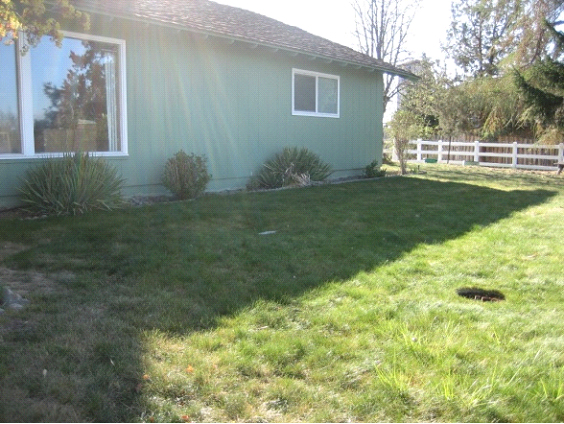You’ve put your home on the market with all appropriate disclosures, including that the home has been heated with natural gas as long as you’ve owned the property. A buyer comes along, makes an offer and hires an inspector. Life is good, right? Not necessarily…
Occasionally, the inspection report states that an underground heating oil tank is probably onsite, at which point the buyer typically requests that the tank be dealt with. The thought of an underground heating oil tank remaining onsite from a previous heating system has never crossed your mind. How did the inspector determine that an underground tank was probably onsite? What happens next?
Visible Signs of an Underground Heating Oil Tank
Typically, the inspector is tipped off by the presence of the pipe used to fill the tank (fill pipe), the pipe used to vent the tank (vent pipe), or both. Sometimes the earth around the fill pipe is black in color, and smells faintly like diesel.
In this picture, the vent pipe and fill pipe can be seen side by side, next to the house.

Here, the vent pipe is next to the house (blue arrow) and the fill pipe is in the yard (yellow arrow).
In the following two pictures, the pipes are side by side in the center of the lawn, underneath a circular cover.
These are just a few examples of tank piping outside of the house, but your piping may look different from the piping in the pictures. If you find unknown piping in your yard, consider taking the cover off and seeing if the pipe smells like petroleum. There may also be evidence of former tank piping inside your residence, near the current furnace, that previously connected the tank to the old furnace.
Who Regulates Underground Heating Oil Tanks?
The Oregon Department of Environmental Quality (DEQ) oversees the Heating Oil Tank (HOT) program (www.oregon.gov/deq/tanks/Pages/hot.aspx), which applies to underground heating oil tanks but not above ground heating oil tanks. The HOT program deals with rules for voluntary decommissioning of HOTs, for licensed HOT contractors, and for cleanup of contamination from a HOT.
The HOT program is notified by the homeowner or DEQ-licensed HOT contractor if a HOT has leaked. The HOT program reviews cleanup reports prepared by the homeowner and/or HOT contractor, and handles other issues related to cleanup of HOT leaks.
What if the HOT is no Longer in Use?
The property owner is required to have all fuel removed from the HOT, and to leave the vent line intact and in place until the HOT is decommissioned. If you are selling your property, you must provide documentation to the buyer showing that the tank has been emptied, so be prepared to share this documentation with your buyer.
Is a HOT Required to be Decommissioned?
Decommissioning a HOT means either removing it, or filling it in place with an inert material. Either way, the HOT must be cleaned before decommissioning, and soil samples must be collected from beneath the HOT. Under current Oregon rules DEQ does not require decommissioning, however, the HOT rules must be followed if a HOT is voluntarily decommissioned. Homeowners can perform their own decommissioning (see details on the DEQ website), complete all necessary documents and submit to DEQ with a fee, for DEQ concurrence that the decommissioning is complete. Alternatively, you can hire a DEQ-licensed HOT Service Provider to decommission the HOT, submit the documents/fee, and receive DEQ concurrence. Please note that only a DEQ-licensed HOT Service Provider can legally be hired to decommission the HOT. Please note that if a release is discovered during decommissioning, you or your licensed Service Provider are required to report the release to DEQ.
What if the HOT is Still Being Used?
As long as the underground HOT isn’t leaking and hasn’t leaked in the past, no action is required. Just be aware that if the HOT begins to leak, or overfills or spills occur, the homeowner is responsible for the cleanup. If you wish to purchase a home with an active underground HOT, consider having it checked for leaks prior to the purchase. It is important to understand that, once you own the property, you are responsible for cleanup of all leaks, both past and present.
Tank Work Takes Time
Keep in mind that tank work (decommissioning as well as cleanup) takes time. A simple decommissioning for a HOT that has not leaked may take a couple of weeks to complete. If a HOT has leaked, allow one to two months, and sometimes more for complex cases, for the HOT Service Provider to complete the site work and prepare the cleanup report. DEQ review typically takes another two to four weeks after the cleanup report has been submitted.
Terry Sprecher is a professional geologist, environmental scientist and Oregon-certified Water Rights Examiner. She works at Sprecher Group (www.sprechergroup.com) and can be reached at 541-306-3709 or terry.sprecher@sprechergroup.com.







